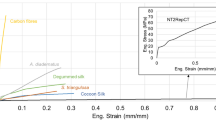Abstract
Motivated by the high level of strength and toughness of spider silk and its multifunctional nature, this paper reports on the engineering properties of individual fibers from Nephila Clavipes spider drag line under uniaxial tension, transverse compression and torsional deformation. The tensile properties were compared to the Argiope Aurentia spider silk and show different ultimate strength but similar traits of the unusual combination of strength and toughness characterized by a sigmoidal stress-strain curve. A high level of torsional stability is demonstrated. comparing favorably to other aramid fibers (including Kevlar fibers).
Similar content being viewed by others
References
J. C. Zemlin, A Study of the Mechanical Behavior of Spider Silks, U. S. Army Natick Report AD, 19.
Frank Ko, Nonlinear Viscoelasticity of Aramid Fibers, Ph. D Thesis, Georgia Institute of Technology, Atlanta, Ga, 1977.
P. N. Witt, C. F. Reed, and D. B. Peakall, A Spider’s Web: Problems in Regulatory Biology, Springer-Verlag, New York, 19b.
V. L. Langer Jr., and R. M. Friedrich,“Fine Structure of Cribellate Spider SiIk”, Am. Zoologist. 9, 91 (1969).
D. B. Peakall, “Synthesis of Silk, Mechanism and Location”, Am. Zoologist, 9, 71(1969)
F. Lucas, J. T. B. Shaw, and S. G. Smith, “Comparative Studies of Fibroins: I. The Amino Acid Composition of Various Fibroins and Its Significance in Relation to Their Crystal Structure and Taxonomy”, J. of Molecular Biology, 2, 339(1960).
J. O. Warwicker, “Comparative Studies of Fibroins”, J. Molecular Biology, 2, 350(1960).
B. J. Marples, “The Spinnerets and Epiandrous Glands of Spiders”, J. Linnean Soc. (Zoology), 46, 209(1967).
R. S. Wilaon, “The Structure of the Dragline Control Valves in the Garden Spiders”, Quart. J. Micr. Sci., 104, 549(1962).
R. S. Wilson, “The Control of Drag Line Spinning in the Garden Spiders”, Quart. J. Micr. Sci., 104, 557(1962).
R. S. Wilson, “Control of Drag-line Spinning in Certain Spiders”, Am. Zoologist, 9, 103(1969).
F. Lucas, J. T. B. Shaw, and S. G. Smith, “The Chemical Constitution of Some Silk Fibroins and Its Bearing on their Physical Properties”, J. Textile Inst., 4, T440 (1955).
H. W. Levi, L. R. Levi, and H. S. Zim, A Guide to Spiders, Golden Press, New York, 1968.
D. Kaplan, W. W. Adams, B. Famler, and C. Viney, editors, Silk Polymers: Materials Science and Biotechnology,.ACS Symposium Series 544, American Chemical Society, DC, 1994
S. Kawabata, Micromeasurement of Mechanical Properties of Single Fibers, PP.311328
R. W. Work, Personal communication.
Author information
Authors and Affiliations
Rights and permissions
About this article
Cite this article
Ko, F.K., Kawabata, S., Inoue, M. et al. Engineering Properties of Spider Silk. MRS Online Proceedings Library 702, 141 (2001). https://doi.org/10.1557/PROC-702-U1.4.1
Published:
DOI: https://doi.org/10.1557/PROC-702-U1.4.1



